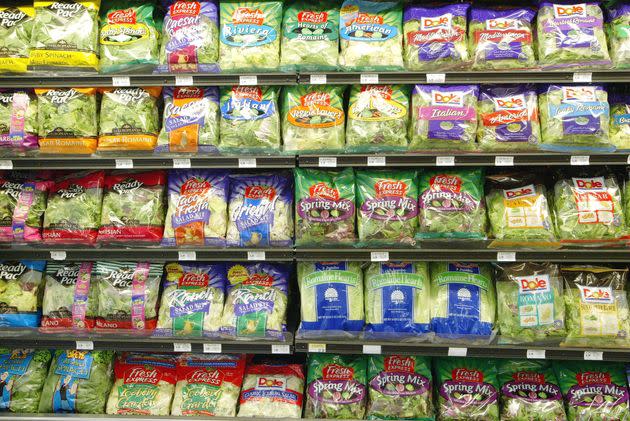Food Safety Experts Won't Buy These 5 Items At The Grocery Store

We all need to eat, but what we buy at the supermarket can make us sick if we aren’t careful.
“Among all industrialized nations, the United States is one of the leading countries for research, laws, regulations, practice, and protocols to maintain food safety,” according to Jagdish Khubchandani, a professor of public health at New Mexico State University who specializes in food safety. Yet, he notes that, according to the Department of Health and Human Services, almost a sixth of the American population will experience a foodborne illness every year. According to the Food and Drug Administration, more than 100,000 of those people will be hospitalized and more than 3,000 will die.
Here’s what food safety experts won’t buy at the grocery store, and why you might want to consider avoiding these items, too.
Pre-cut Fruit
Many fresh fruits cut at the supermarket are not a safe choice according to Darin Detwiler, the chair of the National Environmental Health Association’s Food Safety Program and author of “Food Safety: Past, Present, and Predictions.”
While it’s convenient to buy pre-cut fruit, “convenience should not be a priority over protecting ourselves and our families,” he said. Detwiler told HuffPost that he has seen workers in the produce section cleaning the floor, not washing their hands, then cutting and packaging fruits. He explained that supermarket workers preparing food like fresh fruits “is where we find contamination issues, cross-contamination, and increased time when food is no longer safe and pathogens grow before we even buy them.”
Khubchandani added that there is no easy way “to tell if these are not suitable for consumption, for example, if they are rotten, stale or fermented,” until you get them home and open the packages.
Ready-To-Eat Cooked Foods
Another place pathogens can grow is ready-to-eat cooked foods in the grab-and-go section of supermarkets. These foods are typically prepared in the supermarket and are intended to be consumed right out of the container.
These foods are a no-go for Detwiler. He explained that it’s difficult to keep prepared hot foods hot and cold foods cold. These foods are often stored in the “danger zone,” which the U.S. Department of Agriculture defines as temperatures between 40 degrees and 140 degrees Fahrenheit. When food is in the “danger zone,” bacteria can grow rapidly and make you sick ― especially if it’s there for more than two hours.
Ready-to-eat foods prepared in the supermarket also create a risk of “cross-contamination with dirty hands” and raise allergen concerns, Detwiler said. “This ‘hybrid’ retail restaurant situation is one of those convenience items that increase sales while also increasing risks related to significant failures in food safety,” he said.
Bagged Lettuce
There are “far too many outbreaks and recalls and a lack of transparency and traceability” when it comes to bagged lettuce, Detwiler said.
He has seen “grocery stores bag their own branded leafy greens mix and they have no idea of how many heads of lettuce are in the bag or where they came from.”
Due to several E. coli and listeria outbreaks linked to bagged lettuce, Detwiler recommends buying a whole head of lettuce and washing it yourself. “Why would we still, after all these incidents, just open a bag of mixed, ready-to-eat ‘pre-washed’ leafy greens anymore?” he asked, noting again that convenience should never trump food safety.
Most Deli Counter Items
Khubchandani also avoids most deli counter items and Detwiler is “not a fan of purchasing chicken or ground beef at the meat counter.” According to Detwiler, “Employees often know little about food safety, do not follow ‘first in, first out’ policies, have no idea where the product came from, nor how long it has been there.”
Khubchandani added that employees who prepare these foods may come to work sick, may not follow best practices when it comes to hygiene, and may not be careful about controlling the temperature in the deli case. While there are regulations in place to keep deli counter items safe, “problems are widespread and fairly common,” Khubchandani said.
Detwiler added that because consumers usually can’t see a brand name on the packaging of many deli counter items, there is “no way of determining where it actually came from ... and a recall would not be successful, as we would have no dates or lot codes from the manufacturer,” he explained.
Instead of shopping at the deli counter, Detwiler recommends buying packages labeled with a company name, dates and lot codes, and preparing deli foods at home.

Cantaloupe
In 2011, cantaloupe was the source of a national listeria outbreak that killed at least 33 and sickened 147 other people. This was “one of the country’s most deadly outbreaks of foodborne illness,” Detwiler said.
Cantaloupe is especially prone to causing foodborne illness because it “has an exterior that cannot be cleaned adequately to kill pathogens,” and “the pH inside is at a level that supports rapid growth of pathogens.” When consumers cut cantaloupe with a knife, the bacteria on the skin of the cantaloupe contaminates the inside of the fruit and grows rapidly.
For those who can’t resist cantaloupe, Detwiler said he “would not save any leftovers as more time equals more pathogen growth.” He advises all consumers to stay away from cantaloupe served in restaurants.

